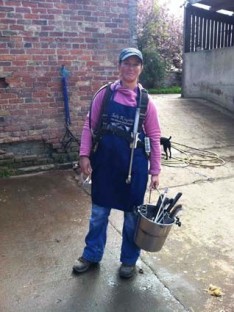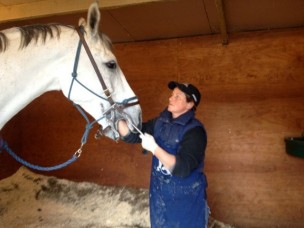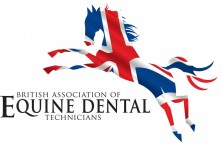Sally Kingsley
Equine Dentistry
Sally Kingsley
Equine Dentistry

Horses develop dental problems now that they live and work largely out of their natural habitat. It's important that the biomechanics of the mouth work so that your horse is comfortable and can chew correctly. Grass contains silica, the building block for glass and so is an abrasive foodstuff. Processed feeds, such as concentrates and even hay are relatively soft and so the horse's teeth don't get such a good workout. As the teeth are worn down they erupt what we call their reserve crown ie. what is stored within the jaw. There should only be about half an inch of tooth above the gum line, within the oral cavity, although the lower teeth often have more crown height than the upper cheek teeth.
The regular pressure of chewing on grass in the natural habitat helps the body regulate the rate at which teeth erupt. Reserve crowns last for approximately 20 -30 years and thus, in the wild determine the hose's life span. When the reserve crown has run out the roots start to erupt, but because they are made of a softer substance and become wobbly they provide only temporary relief. Normal chewing involves firstly nipping off grass with the incisors (front teeth) and then passing the wad of food back to the cheek teeth with the tongue. The horse doesn't chew up and down like a human but in a sideways and circular motion to maximise grinding on the cheek teeth surfaces.
Methodical chewing thoroughly mixes saliva with the food to form a 'bolus' which is steadily passed backward down the cheek teeth 'battery' to be swallowed. Then the horse lowers his head again ready to take the next bite; this may be chewed on either the right or left side - only one side is usually used per mouthful. The perfect horse will use both sides evenly but often like us horses prefer to chew on one side. This can be through discomfort or, presumably, preference and can lead to problems.

We have taken the horse out of his natural habitat and placed him in an enclosed space. Most of his diet is now processed ie. hay and hard food, and there are not enough horses that graze outside for more than 12 hours per day. Fed on processed feeds our horses no longer use their front teeth so much and their incisors can get longer relative to their cheek teeth, preventing proper occlusion (meeting) of the back grinders. This can cause problems for the horse which you might not be aware of: TMJ or jaw joint pain- he may be unsteady on the bit, wave mouth, hooks, sharp points and inability to grind his food correctly. This in turn can lead to weight loss and even colic. Often we feed from a height as opposed to floor level and so the horse develops hooks and ramps on his cheek teeth as well as other oral problems. We have bred horses for prettier heads and this has been at the expense of dental conformation: the horses and ponies with finer, dainty heads seem to suffer most often with congenital abnormalities such as overcrowding or absence of certain teeth.
